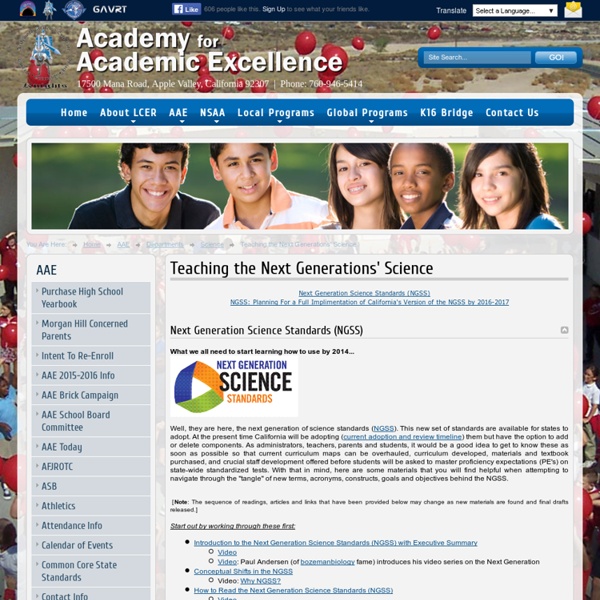Lewis Center for Educational Research - Teaching the Next Generations' Science

Next Generation Science Standards Home - CESA 2
Welcome to the CESA depository of professional development materials for understanding and implementing the Next Generation Science Standards. These materials and this page are still continuing in their development, so please let us know of any feedback you may have. These materials were developed as part of a CESA led committee that included Chad Janowski, Judy Sargent, Eric Brunsell, Shelley Lee, Dennis Kostac, Curt Julian, Kevin Anderson, Ellen Van Pay and Laurie Mitchell. Kevin's First Letter on Adoption of the Wisconsin Next Generation Science Standards (aka WINGSS) NGSS links and PD resources (focus on CESA #2 workshop materials) Half-day Overview of the NGSS - powerpoint slides for a half day K-12 overview NGSS in DCI view and the NGSS in topic view - updated version as of May 1, 2013 with math and ELA connections Timeline and planning for NGSS Roll out - ideas for rolling out the NGSS in your districts Presentation Slides - general - overview of the NGSS CESA Science PD Materials
The Einstein Project
Free K - 12 Common Core Lesson Plans and Ideas
Sixth Grade Reading: Informational Text Scroll Up Scroll Down back Key Ideas and Details: Cite textual evidence to support analysis of what the text says explicitly as well as inferences drawn from the text. 107 Lesson(s) Determine a central idea of a text and how it is conveyed through particular details; provide a summary of the text distinct from personal opinions or judgments. 72 Lesson(s) Analyze in detail how a key individual, event, or idea is introduced, illustrated, and elaborated in a text (e.g., through examples or anecdotes). 16 Lesson(s) Craft and Structure: Determine the meaning of words and phrases as they are used in a text, including figurative, connotative, and technical meanings. 35 Lesson(s) Analyze how a particular sentence, paragraph, chapter, or section fits into the overall structure of a text and contributes to the development of the ideas. 24 Lesson(s) Determine an author's point of view or purpose in a text and explain how it is conveyed in the text. 23 Lesson(s) 17 Lesson(s)
National Curriculum Standards for Social Studies: Chapter 2—The Themes of Social Studies
Standards Main Page Executive Summary Preface Introduction Thematic Strands Social studies programs should include experiences that provide for the study of culture and cultural diversity. Human beings create, learn, share, and adapt to culture. Cultures are dynamic and change over time. Through experience, observation, and reflection, students will identify elements of culture as well as similarities and differences among cultural groups across time and place. In schools, this theme typically appears in units and courses dealing with geography, history, sociology, and anthropology, as well as multicultural topics across the curriculum. Social studies programs should include experiences that provide for the study of the past and its legacy. Studying the past makes it possible for us to understand the human story across time. Knowing how to read, reconstruct and interpret the past allows us to answer questions such as: How do we learn about the past?
Related:
Related:



